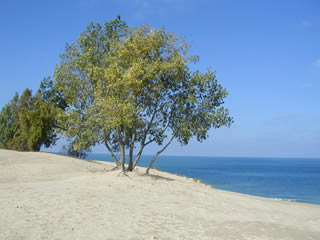|

Sand
Dunes
Dunes are created when:
"1. a plentiful supply of sand combines with,
2. wind blowing mostly from one direction, and
3. a natural trap causes the wind to drop the sand" (United
States).
Indiana sand dunes are part of
the Lake Michigan border
section located in the northwestern
part of the state. Dune land is made up of sand and piles
of rocky glacial till (a mixture of sand, clay, and gravel),
which are called moraines. Moraines were formed by past glacier
movement that deposited till along its path. The sand piles
are evidence of the lake's annual recession. For example,
due to the northwest winds, Mt. Baldy, which is one of the
tallest sand dunes standing at 123 feet, advances inland at
a rate of four to five feet a year.
The dunes are adjacent to Lake
Michigan and occupy only a narrow strip of land, a few miles
wide at most. A few remnants of "older" sand dunes
that extended as far south as Valparaiso
(older because, as the lake shrank back in stages, new shoreline
formed farther north) still exist as well. However, most of
these older dunes and their adjoining ecosystems (such as
wetlands and forests)
have been leveled and drained for industrial or agricultural
purposes.
The first person to recognize
the diversity of this rich collection of habitats was Henry
Chandler Cowles, a professor at the University of Chicago.
Because of Cowles' explorations, beginning in the late 1800s,
ecology was developed as a scientific discipline on the Indiana
shores of Lake Michigan.
Cowles noted and observed natural
systems, such as plant succession, which is the "change
from one type of habitat to another.... [It] explains the
change from a simple to a complex plant community in a predictable,
orderly process" (State of Indiana). The dunes ecosystem
represents a thorough example of plant succession. The sand
dunes are part of a 15,000-acre expanse of shoreline, forest,
and wetlands. On the beach, only a few strong plants, such
as sea rocket, bug-seed, and seaside spurge, survive. The
next sandy layer back is called the foredune, which is characterized
by deep-rooted grasses, such as the little bluestem, beach
grass, sand-reed grass, as well as some shrubbery. Pannes,
which are shallow depressions in the sand caused by the wind
and that retain water much of the year, are scattered among
the foredunes. The shoreline and foredunes could also be classified
as prairie ecosystems since they
are dry, and only deep-rooted, tough plants can survive there.
The foredunes are then followed
by the high dunes, where two plant communities exist. The
south-facing slopes are composed of a savanna of white and
black oaks and wildflowers, while the north-facing slopes
are covered with red oaks, basswood, and flowering dogwood.
This high dune area gives way to upland and lowland forests,
which together constitute the majority of the area. The upland
forests are made up of three forest types: oak, coniferous,
and mixed deciduous. The lowland forests are the second largest
habitat in the area behind the upland forests.
Finally, within
these habitats lie several types of wetlands, including marshes,
aquatic shrublands, swamps, bogs, pannes, and open water.
Several animal
species make up the population in the dune habitats, including
the white-footed mouse (plus several other species of mice
and rats), raccoons, white-tailed deer, short-tailed shrews,
possums, woodchucks, rabbits, squirrels, bats, and, specific
to the wetland area, muskrats.
It is hard to believe that an
ecosystem that is home to so many plants and animals, and
that supports several habitats, was once thought by the early
settlers to be a wasteland. On the contrary, the sand dunes
are a rich example of Indiana's diverse landscape.
Sources:
State of Indiana.
Dept. of Natural Resources. "Natural Areas and Native
and Exotic Species." A Synthesis of Major Topics
in the Lake Michigan Coastal Area. 2000. 13 Nov. 2002
<www.state.in.us/nrc_dnr/lakemichigan/natural/
natural1.html>.
United States. National
Park Service. "Geology Fieldnotes: Indiana Dunes National
Lakeshore." Geology of Indiana Dunes National
Lakeshore.
26 Jan. 1998. 27 June 2004 <www2.nature.nps.gov/grd/parks/indu/>.
Whitaker, John O.,
Jr., John Gibble, and Eric Kjellmark. Mammals of Indiana
Dunes National Lakeshore. Washington: National Park Service,
1994.
|




